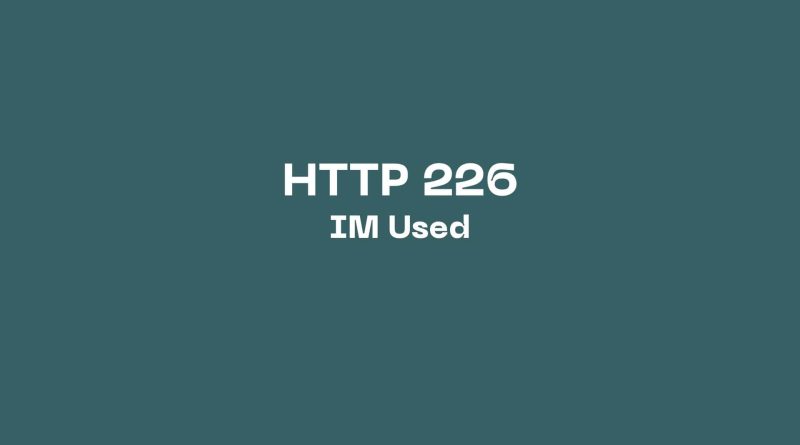The Ultimate Guide to HTTP 226 (IM Used) Status Code
We’ve all been there. You’re trying to access a web page and you get one of those pesky HTTP status codes, in this case 226 (IM Used). What does it mean? Is your internet connection not working properly or is something else going on? Fear not! I’m here to provide the ultimate guide to help you understand what an HTTP 226 (IM Used) code means.
The most common reason for seeing an HTTP 226 (IM Used) message is when content has been sent with ‘partial GET’ requests. That might sound like gibberish but don’t worry – by the end of this article, you’ll be able to explain exactly what that means. We’ll cover everything from understanding why partial GETs are used in the first place, to diagnosing problems related to them.
What Is Http Status Code 226 Im Used?
HTTP status code 226 “IM Used” is a relatively uncommon status code that indicates that the server has fulfilled a request for a resource, and the response is a representation of the result of one or more instance manipulations applied to the current instance.
This status code is typically used in situations where an origin server implements the HTTP “Immutable” response header field, which indicates that a resource has not been modified since a previous HTTP request.
The HTTP “Immutable” response header field is used to indicate that a resource has not been modified since a previous request. This is useful in situations where a resource is expected to remain unchanged over time, and clients can take advantage of this by caching the resource and reusing it without having to make a new request to the server.
When a client makes a request for a resource that has the “Immutable” header set, and the server determines that the resource has not been modified since the last request, it can respond with HTTP status code 226 “IM Used”. This tells the client that the requested resource is the same as the one it previously received and that it can use the cached copy of the resource.
The “IM Used” status code is relatively new and not widely used. It was introduced in the HTTP/1.1 specification in 2014 and is not supported by all web servers and clients. It’s worth noting that some older clients may interpret this response status code as an error code and may not handle it correctly, so it should be used with caution.
This type of response is often seen with web applications or scripts that utilize automated request processing such as file downloads, image resizing, and other similar tasks. In many cases, this type of response helps keep track of which requests were successful in order to inform any further actions taken by either side.
Having a reliable system that uses HTTP status codes like 226 allows us to accurately monitor our interactions with remote servers so we can respond quickly if any issues arise during processing.
HTTP 226 IM Used Example
here is an example of a communication flow between a client and server where the server responds with HTTP status code 226 “IM Used”:
- The client sends a GET request method to the server for a resource, such as an image or a video file, with an If-None-Match header to check if the resource has been modified since the last request:
GET /image.jpg HTTP/1.1
Host: example.com
If-None-Match: "xyz123"
- The server receives the request and determines that the resource has not been modified since the last request, and includes the “Immutable” header in the response:
HTTP/1.1 226 IM Used
Server: Apache
Content-Type: image/jpeg
Content-Length: 12345
Cache-Control: public, max-age=3600, immutable
Etag: "xyz123"
Last-Modified: Mon, 01 Jan 2023 00:00:00 GMT
- The client receives the response from the server and can use the cached copy of the resource without having to make a new request to the server.
It’s important to note that the “IM Used” status code is not commonly used, and many clients may not support it. Therefore, it’s recommended to use the more commonly supported HTTP status codes for similar scenarios, such as 304 Not Modified or 200 OK with a cache control header.
Similar Status Codes To Http 226?
There are not many similar HTTP status codes to 226, as it is a unique code. However, there are a few other status codes that may be relevant in certain situations:
- HTTP status code 200 “OK”: This code is used when a request has succeeded and the server returns a response with the requested information. While not exactly the same as 226, it does indicate that the request was successful and the server was able to provide the requested information.
- HTTP status code 202 “Accepted”: This code is used when a request has been accepted for processing, but the processing has not been completed. It is possible that this code could be used in situations where instance manipulations are being performed, but the response is not a representation of the final result.
- HTTP status code 300 “Multiple Choices”: This code is used when a request has more than one possible response. While not directly related to instance manipulations, it could be used in situations where multiple representations of a resource are available.
Overall, while there are not many direct alternatives to HTTP status code 226, there are other codes that could be used in certain situations where instance manipulations are being performed.
Http 226 Status Code Compatibility?
HTTP 226 status code is compatible with all browsers. It is part of the HTTP protocol, which defines a set of request header fields and response status codes that are sent between a user agent and a web server during communication.
The current version of HTTP 226 supports most major browsers including Chrome, Firefox, Safari, and Edge. These browsers adhere to the standards defined by IETF RFC 7231 (Hypertext Transfer Protocol), which states that any device must react in accordance with these protocols while working together with other devices over the same network. In addition, this also ensures compatibility across different platforms like Android, iOS, Linux etc., as they all use similar base-level technologies to process information and data exchanges between clients and servers.
All HTTP status codes by categories
Informational responses
(100 – 199)


